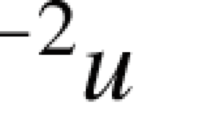Abstract
For a class of Hamiltonians including a model of the quantum detector of gravitational waves, we prove the strong convergence of the Schrödinger evolution to quantum stochastics. We show that the strong resolvent limit of a sequence of self-adjoint Hamiltonians is a symmetric boundary-value problem in Fock space, and the limit evolution of the partial trace with respect to the mixed state cannot be described by a unique equation of Lindblad type. On the contrary, each component of the mixed state generates a proper evolution law.
Similar content being viewed by others
REFERENCES
S. Albeverio, W. Karwowski, and V. Koshmanenko, “Square powers of singularly perturbed operators, ” Math. Nachr., 173 (1995), 5–24.
A. M. Chebotarev, “Quantum stochastic differential equation is unitarily equivalent to a boundary problem for the Schrödinger equation, ” Mat. Zametki [Math. Notes], 61 (1997), no. 4, 612–622.
A. M. Chebotarev, Lectures on Quantum Probability, vol. 14, Sociedad Matemática Mexicana, Aportaciones Matemáticas, México, 2000.
T. Kato, Perturbation Theory for Linear Operators, Springer-Verlag, New-York, 1976.
A. M. Chebotarev, “What is a quantum stochastic differential equation from the point of view of functional analysis, ” Mat. Zametki [Math. Notes], 71 (2002), no. 3, 448–469.
R. L. Hudson and K. R. Parthasarathy, “Quantum Ito's formula and stochastic evolutions, ” Comm. Math. Phys., 93 (1984), no. 3, 301–323.
K. R. Parthasarathy, An Introduction to Quantum Stochastic Calculus, Birkhauser, Basel, 1992.
P. A. Meyer, “Quantum Probability for Probabilists, ” in: Lecture Notes in Math, vol. 1338,Springer-Verlag, Berlin, 1993.
G. Lindblad, “On the generators of quantum dynamical semigroups, ” Comm. Math. Phys., 48 (1976), no. 2, 119–130.
V. Gorini, A. Kossakowski, and E. C. G. Sudarshan, “Completely positive dynamical semigroups of n-level systems, ” J. Math. Phys., 17 (1976), no. 3, 821–825.
F. A. Berezin, The Method of Second Quantization, Academic Press, New-York, 1996.
A. M. Chebotarev, “On the symmetric form of the Hudson–Parthasarathy quantum stochastic equation, ” Mat. Zametki [Math. Notes], 60 (1996), no. 5, 726–750.
F. Fagnola, “On quantum stochastic differential equations with unbounded coefficients, ” Prob. Theory and Related Fields, 86 (1990), 501–516.
F. Fagnola, “Unitarity of solutions to quantum stochastic differential equations and conservativity of the associated semigroup, ” in: Quantum Probability and Related Topics, vol. VII, World Scientific, Singapore, 1992, pp. 139–148.
F. Fagnola, “Characterization of isometric and unitary weakly differentiable cocycles in Fock space, ” in: Quantum Probability and Related Topics, vol. VIII, World Scientific, Singapore, 1993, pp. 143–164.
Author information
Authors and Affiliations
Rights and permissions
About this article
Cite this article
Chebotarev, A.M., Ryzhakov, G.V. On the Strong Resolvent Convergence of the Schrödinger Evolution to Quantum Stochastics. Mathematical Notes 74, 717–733 (2003). https://doi.org/10.1023/B:MATN.0000009005.56775.7c
Issue Date:
DOI: https://doi.org/10.1023/B:MATN.0000009005.56775.7c




